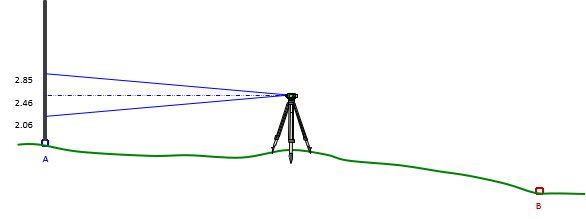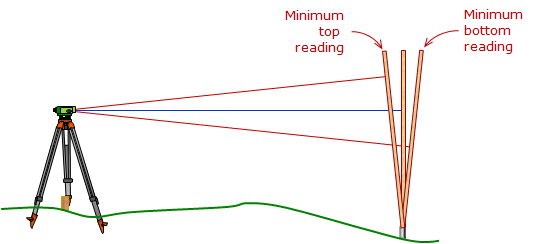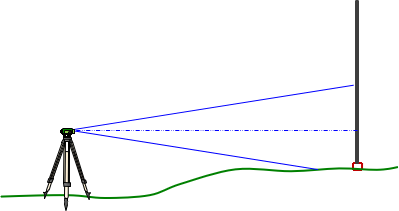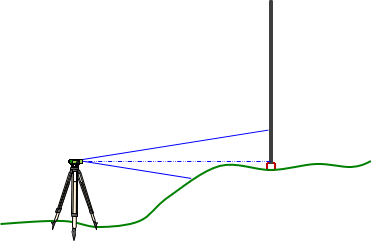{KomentoDisabled}
G. Three-Wire Leveling
1. Principle
Three-wire leveling is so named because it uses all three horizontal crosshairs (wires) for backsight (BS) and foresight (FS) readings. The top and bottom are commonly called stadia crosshairs or stadia wires, Figure G-1, and are equally spaced on both sides of the center wire.
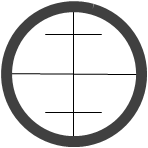 |
| Figure G-1 Stadia Wires |
Reading all three wires:
- allows distance determination (stadia)
- refines and checks BS and FS readings
The stadia principle is described in V. Distance Measurement Methods.
2. Wire Readings and Check
Figure G.2 shows shows a rod BS with the three wire readings.
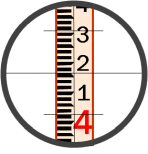 |
top: 4.31 middle: 4.16 bottom: 4.02 |
|
| Figure G-2 Reading All Three Wires |
||
Because the wires are equally spaced, the center reading should be the average of all three. The average may not exactly match the center reading because all three readings are subject to random errors.
Average = (4.31+4.16+4.02) / 3 = 4.163' which closely matches the middle reading
The BS reading is 4.163. We're carrying an additional decimal place because:
It's the result of multiple readings
It conforms with significant figures rules; the reading sum is 12.49 which has 4 sig fig.
The stadia interval, i, is the difference between the top and bottom wires: i = 4.31-4.02 = 0.29'
If instrument's stadia multiplier is 100, then the horizontal distance to the rod is 100(0.29') = 29'
Except for reading all three wires, and field note modification, the process of three-wire leveling is the same as differential leveling:
Elev Inst = ElevA + BSA
ElevB = Elev Inst - FSB
In differential leveling, however, a reading error is hard to trap since only the center wire is read. In three-wire leveling, reading errors are immediately identified and can be corrected.
3. Field notes
Field notes may seem complex at first, but that's only because of all the readings and running computations. Wire readings are recorded top-middle-bottom in the respective column (BS or FS). Computations are done immediately to catch reading errors and determine distances.
An example serves to illustrate how the notes are compiled.
A circuit is run from point A (elev = 853.12) to point B then to point C. The rod numbers on the diagrams are the top, middle, and bottom wire readings. The stadia multiplier for the instrument used is 100.
a. Set up the field note left plate
The interval column will be used to perform distance computations

b. Set up midway between points A and B
(1) Backsight point A and record readings in BS column
|
|
| Figure G-3 BS on Point A |

(2) Running computations
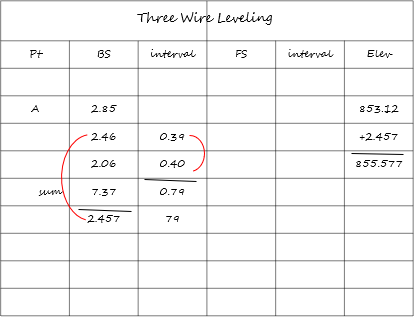
Add the readings and divide by three for the BS value: 2.85+2.46+2.06=7.37; 7.37/3 = 2.457
The average (2.457) should be approximately the same as the middle reading (2.46).
If it isn't, that means there is at least one reading error; check the readings again.
Add the average BS to the elevation of point A to get the elevation of the instrument: 853.12+2.457 = 855.577
Compute the sub-intervals: (top - middle) and (middle - bottom) readings; 2.85-2.46 = 0.39 and 2.46-2.06 = 0.40.
These should be approximately equal to each other, taking into account reading errors.
Add the sub-intervals to obtain the rod interval, i: 0.39+0.40 = 0.79
Apply the stadia multiplier to get the distance: H = 100. (0.79) = 79'
(3) Rotate to and take FS readings on point B; Record in FS column
 |
| Figure G-4 FS on Point B |

(4) Running computations
Perform the same computations for the FS readings as were done for the BS readings.

Subtract the average FS reading from the instrument elevation to get the elevation of point B: 855.577-4.607 = 850.970
The FS distance should be close to the BS distance (81' and 79') in order for distance-based systematic errors to cancel.
c. Move instrument to between points B and C.
(1) Backsight on point B; Record in BS column
 |
| Figure G-5 BS on Point B |
(2) Running computations
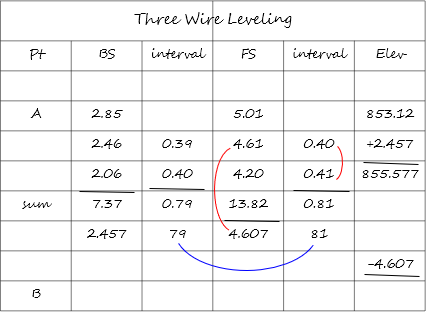
(3) FS on point C; Record in FS column
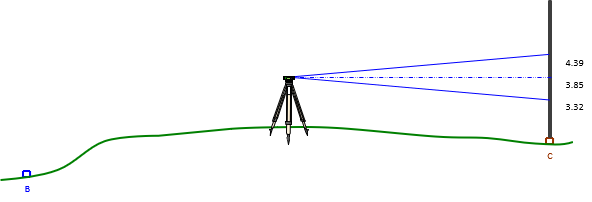 |
| Figure G-6 FS on Point C |
(4) Running computations
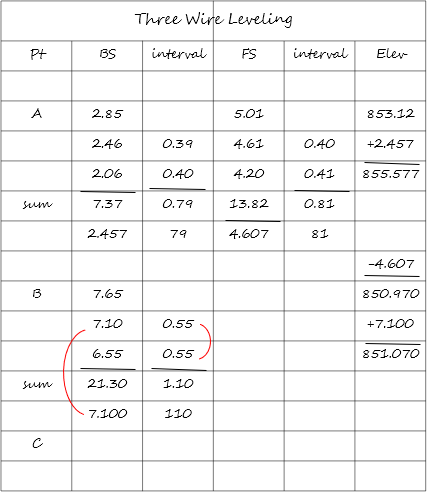
d. Perform a page check
As in differential leveling, a page check should be perform to catch math errors. Two setups will fit on a single plate leaving enough space for a page check.
The page check is: Begin elev + BS sum - FS sum = End elev

4. Error Sources and Behavior
Errors affecting differential leveling also affect three-wire leveling. Additional errors by sources include:
a. Instrumental
(1) Uneven stadia wire spacing
(a) Principle and Behavior
While sometimes an error on older instruments, this is generally not an issue on modern ones. If one sub-interval is consistently larger or smaller than the other, then there may be an instrumental error. Sub-intervals are a function of distance, making the error systematic.
(b) Compensation
Balancing BS and FS distances differences allow wire spacing errors to compensate.
(2) Incorrect stadia multiplier
(a) Principle and Behavior
The multiplier is based on the stadia wire spacing with most modern instruments having a multiplier of 100. An incorrect multiplier introduces a systematic error.
(b) Compensation
If stadia is used to balance BS and FS distances, then the systematic error is irrelevant.
What if the distances are needed for a proportional adjustment of a level circuit? Does the error in them affect the adjustment? No, because each distance is increased or decreased by the same amount, as is their total.
(3) Rod bubble
(a) Principle and Behavior
In three-wire leveling, a rod bubble must used to hold the rod vertical. Waving the rod, as for differential leveling, does not work for three-wire leveling. The lines of sight for the top and bottom wires are not horizontal so their correct readings do not occur at their minimum values, Figure G-7.
|
|
| Figure G-7 Rod Waving Error |
(b) Compensation
Use an adjusted rod bubble to ensure the rod is held vertically.
b. Natural
(1) Obstructed wire
(a) Principle and Behavior
Because the stadia wire spread increases with distance, the bottom wire may "ground out", Figure G-8(a), or top wire pass over the rod, G-8(b).
|
|
|
| (a) Bottom Wire | (b) Top Wire |
| Figure G-8 Wire Missing Rod |
|
The behavior is systematic because it is based on distance.
(b) Compensation
Sight distances should be kept short to ensure all three wires can be read on the rod. Distances may need to be further shortened on rolling terrain, Figure G-9.
|
|
| Figure G-9 Rolling Terrain |
The surveyor could use the middle wire reading instead of the average of all three and double the single sub-interval to determine the distance. This shouldn't be done because:
- there are no reading checks
- the center reading isn't as accurate as an average is
- doubling the sub-interval magnifies the reading errors
c. Personal
Because there are more readings and running computations, there is greater opportunity for reading, recording, and calculation mistakes. Mistake reduction comes from experience and diligence.
